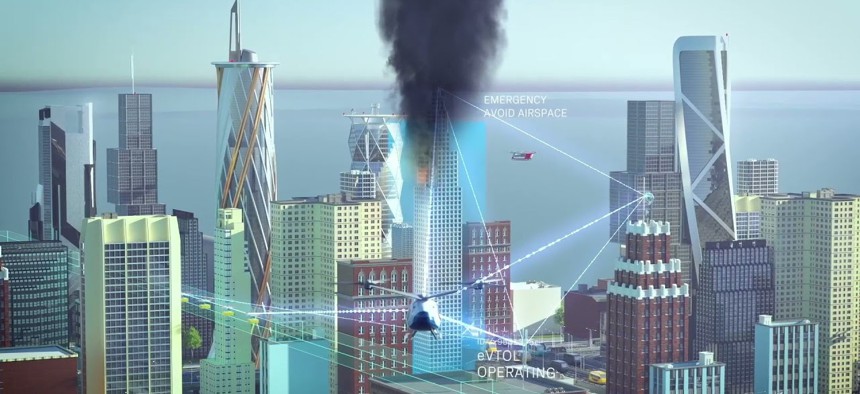NASA weaves a data and AI fabric for drone intelligence

NASA / Aeronautics Research Mission Directorate (ARMD) / Transformative Aeronautics Concepts Program (TACP) / Convergent Aeronautics Solution (CAS) Project
A Data and Reasoning Fabric will not only pass relevant information to drones and allow them to share information, but also feature AI and machine learning services that will allow unmanned systems to operate safely in close quarters.
Before the skies can fill with autonomous vehicles to spot fires, locate lost hikers, deliver medical supplies or improve situational awareness for first responders, operators will need a decentralized, intelligent information ecosystem where data and services can be securely exchanged in real time.
NASA is spearheading a project to build a Data and Reasoning Fabric (DRF) that will not only pass relevant information to drones and allow them to share information, but also feature AI and machine learning services that will allow unmanned systems to make informed decisions autonomously so they can operate safely in close quarters. Just as drivers make commuting decisions based on real-time weather and traffic data, highway regulations and accident reports, autonomous aircraft will need data and reasoning tools to make real-time navigation decisions.
DRF envisions a digital “marketplace” where providers like weather services, mapping and surveying firms, local governments and air traffic management can provide their data and artificial intelligence- and machine learning-based services to aircraft operators through digital contracts. In turn, operators can also offer the data and reasoning they have acquired back to infrastructure providers.
The web-like ecosystem “will allow all users to quickly find, verify, purchase, and securely use data from data providers and reasoning services owned by many small and large industry and government organizations,” NASA said in DRF concept brochure.
The fabric’s decentralized peer-to-peer architecture leverages open standards for real-time decision support across the entire span of mobility. It features systemwide monitoring, built-in security and governance and the software to manage scalable data sharing and reasoning services, according to Autonomy Association International, NASA’s partner in the DRF demonstration program.
In a wildfire tracking use case, ground-based, aerial and space-based sensors would inform real-time decision making. The fire might first be spotted by satellites that automatically alert appropriate aviation controllers and emergency responders who then coordinate response planning through the DRF marketplace. Responders’ surveillance drones would communicate with both the satellites and ground-based operators to monitor the fire.
In another use case, a drone delivering a package across town would connect to the DRF, an a nearby node would provide it with weather information, a detailed map from city authorities and the locations of nearby aircraft -- all assembled using data from the marketplace.
According to a NASA release, after receiving this information from DRF, the drone’s software would analyze the data and determine that the weather is acceptable, that it should fly above 200 feet to avoid a building and that it must allow room for an air taxi flying nearby. If a storm is moving in, decision support tools enabled by DRF could send the drone a new flight plan that avoids weather so it can safely and efficiently complete the mission with minimal human input.
Stakeholders from industry, academia, tribal nations, community organizations, and government, including more than 22 cities across Maricopa, Pinal, Pima and Yuma counties in Arizona are working with AAI on a demonstration project. “This work will serve as a blueprint for not only Arizona in how to realize smart data for the autonomous world, but also offer cities across the United States, and the world, a model to execute their own vision of smart mobility,” an AAI spokesperson said.
While DRF is designed to address the needs of an advanced air mobility system, the vision is has relevance to the broader transportation network where it can increase capacity and reduce delays, NASA said.
A demonstration in late 2022 or early 2023 involving Arizona and the greater Phoenix area will show how DRF can enhance and help users adapt to the evolving airspace.
NEXT STORY: California dives into blockchain






